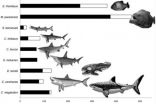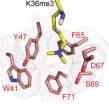(Press-News.org) If the sinful excess of holiday eating sends your system into butter-slathered, brandy-soaked overload, you are not alone: People who are jet-lagged, people who work graveyard shifts and plain-old late-night snackers know just how you feel.
All these activities upset the body's "food clock," a collection of interacting genes and molecules known technically as the food-entrainable oscillator, which keeps the human body on a metabolic even keel. A new study by researchers at the University of California, San Francisco (UCSF) is helping to reveal how this clock works on a molecular level.
Published this month in the journal Proceedings of the National Academy of Sciences, the UCSF team has shown that a protein called PKCγ is critical in resetting the food clock if our eating habits change.
The study showed that normal laboratory mice given food only during their regular sleeping hours will adjust their food clock over time and begin to wake up from their slumber, and run around in anticipation of their new mealtime. But mice lacking the PKCγ gene are not able to respond to changes in their meal time – instead sleeping right through it.
The work has implications for understanding the molecular basis of diabetes, obesity and other metabolic syndromes because a desynchronized food clock may serve as part of the pathology underlying these disorders, said Louis Ptacek, MD, the John C. Coleman Distinguished Professor of Neurology at UCSF and a Howard Hughes Medical Institute Investigator.
It may also help explain why night owls are more likely to be obese than morning larks, Ptacek said.
"Understanding the molecular mechanism of how eating at the "wrong" time of the day desynchronizes the clocks in our body can facilitate the development of better treatments for disorders associated with night-eating syndrome, shift work and jet lag," he added.
Resetting the Food Clock
Look behind the face of a mechanical clock and you will see a dizzying array of cogs, flywheels, reciprocating counterbalances and other moving parts. Biological clocks are equally complex, composed of multiple interacting genes that turn on or off in an orchestrated way to keep time during the day.
In most organisms, biological clockworks are governed by a master clock, referred to as the "circadian oscillator," which keeps track of time and coordinates our biological processes with the rhythm of a 24-hour cycle of day and night.
Life forms as diverse as humans, mice and mustard greens all possess such master clocks. And in the last decade or so, scientists have uncovered many of their inner workings, uncovering many of the genes whose cycles are tied to the clock and discovering how in mammals it is controlled by a tiny spot in the brain known as the "superchiasmatic nucleus."
Scientists also know that in addition to the master clock, our bodies have other clocks operating in parallel throughout the day. One of these is the food clock, which is not tied to one specific spot in the brain but rather multiple sites throughout the body.
The food clock is there to help our bodies make the most of our nutritional intake. It controls genes that help in everything from the absorption of nutrients in our digestive tract to their dispersal through the bloodstream, and it is designed to anticipate our eating patterns. Even before we eat a meal, our bodies begin to turn on some of these genes and turn off others, preparing for the burst of sustenance – which is why we feel the pangs of hunger just as the lunch hour arrives.
Scientist have known that the food clock can be reset over time if an organism changes its eating patterns, eating to excess or at odd times, since the timing of the food clock is pegged to feeding during the prime foraging and hunting hours in the day. But until now, very little was known about how the food clock works on a genetic level.
What Ptacek and his colleagues discovered is the molecular basis for this phenomenon: the PKCγ protein binds to another molecule called BMAL and stabilizes it, which shifts the clock in time.
###
The article, "PKCγ participates in food entrainment by regulating BMAL1" is authored by Luoying Zhang, Diya Abrahama, Shu-Ting Lin, Henrik Oster, Gregor Eichele, Ying-Hui Fu, and Louis J. Ptácek and appears in the Proceedings of the National Academy of Sciences. See: http://www.pnas.org/content/109/50/20679.abstract.
In addition to UCSF, authors on the study are affiliated with the Max Planck Institute of Biophysical Chemistry in Göttingen, Germany.
This work was supported by the National Institutes of Health via grants #GM079180 and #708 HL059596, the Sandler Neurogenetics Fund, and the Howard Hughes Medical Institute. END
Children suspected of having appendicitis are more likely to receive CT scans, which involve radiation, if they are evaluated at a general hospital, a new study by Washington University School of Medicine in St. Louis has shown.
Similar patients who went to St. Louis Children's Hospital were more often evaluated with an ultrasound scan, a safer option that uses sound waves instead of radiation to confirm or rule out the need for surgery to remove the appendix.
Use of either scanning technique can potentially reduce the occurrence of unnecessary surgeries and expedite ...
AMHERST, Mass. – Contributing geometric and topological analyses of micro-materials, University of Massachusetts Amherst mathematician Robert Kusner aided experimental physicists at the University of Colorado (UC) by successfully explaining the observed "beautiful and complex patterns revealed" in three-dimensional liquid crystal experiments. The work is expected to lead to creation of new materials that can be actively controlled.
Kusner is a geometer, an expert in the analysis of variational problems in low-dimensional geometry and topology, which concerns properties ...
By the time they reached toddlerhood, very preterm infants originally treated with higher oxygen levels continued to show benefits when compared to a group treated with lower oxygen levels, according to a follow-up study by a research network of the National Institutes of Health that confirms earlier network findings. Moreover, infants treated with a respiratory therapy commonly prescribed for adults with obstructive sleep apnea fared as well as those who received the traditional therapy for infant respiratory difficulties, the new study found.
In the original 2010 ...
Human corneal endothelial cells (HCEnCs) form a monolayer of hexagonal cells whose main function is to maintain corneal clarity by regulating corneal hydration. Cell loss due to aging or corneal endothelial disorders, such as Fuchs dystrophy, can lead to cornea edema and blindness, resulting in the need for cornea transplants.
Studying human corneal endothelium has been difficult for cell biologists because limited cellular model systems exist and have significant drawbacks. The major drawback is that HCEnC cells do not divide and there is a limited source of these cells ...
As anyone familiar with the X-Men knows, mutants can be either very good or very bad — or somewhere in between. The same appears true within cancer cells, which may harbor hundreds of mutations that set them apart from other cells in the body; the scientific challenge has been to figure out which mutations are culprits and which are innocent bystanders. Now, researchers at Johns Hopkins Medicine have devised a novel approach to sorting them out: they generated random mutations in a gene associated with lymphoma, tested the proteins produced by the genes to see how they ...
ROCHESTER, Minn. -- For nearly a decade, breast cancer researchers studying the hormone therapy tamoxifen have been divided as to whether genetic differences in a liver enzyme affect the drug's effectiveness and the likelihood breast cancer will recur. A new study by researchers from the Mayo Clinic Cancer Center and the Austrian Breast and Colorectal Cancer Study Group provides evidence that genetic differences in the enzyme CYP2D6 play a key role in how well tamoxifen works.
"Our findings confirm that, in early breast cancer treated with tamoxifen, genetic alterations ...
PHILADELPHIA – Nearly half of the 700,000 cancer patients who undergo surgical removal of a primary tumor each year suffer a recurrence of their disease at some point, and many of those patients will eventually die from their disease. The traditional view of recurrent tumors is that they are resistant to therapy because they've acquired additional genetic mutations that make them more aggressive and impervious to drugs. Now, however, researchers at the Perelman School of Medicine at the University of Pennsylvania show in an animal model that the enhanced aggressiveness ...
Taking into consideration its size, an ancient relative of piranhas weighing about 20 pounds delivered a bite with a force more fierce than prehistoric whale-eating sharks, the four-ton ocean-dwelling Dunkleosteus terrelli and – even – Tyrannosaurus rex.
Besides the force of the bite, Megapiranha paranensis appears to have had teeth capable of shearing through soft tissue the way today's piranhas do, while also being able to pierce thick shells and crack armoring and bones, according to Stephanie Crofts, a University of Washington doctoral student in biology.
"If our ...
Many of the most common inpatient surgeries in the United States are performed electively. These surgeries are expected to significantly increase with the enactment of the Affordable Care Act. In a new perspectives article, published in the Dec. 27 edition of The New England Journal of Medicine, a team of Weill Cornell Medical College researchers are recommending the nation's health care leaders and medical community join forces to establish evidence-based appropriateness criteria to determine which patients are most in need of elective procedures, such as joint replacement ...
CHAPEL HILL - Long-standing research efforts have been focused on understanding how stem cells, cells capable of transforming into any type of cell in the body, are capable of being programmed down a defined path to contribute to the development of a specific organ like a heart, lung, or kidney. Research from the University of North Carolina at Chapel Hill School of Medicine has shed new light on how epigenetic signals may function together to determine the ultimate fate of a stem cell.
The study, published December 27, 2012 by the journal Molecular Cell, implicates ...


